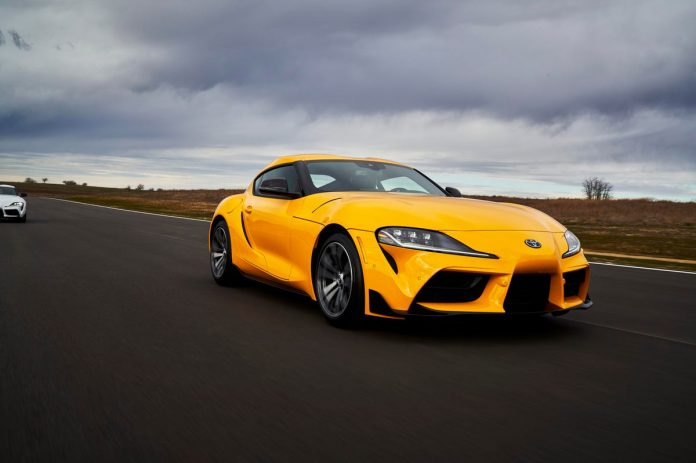Toyota Supra.
TOYOTA
There is no doubt that the new Toyota Supra is an incredible eye-catcher. I’m well past the age of using cars to troll for the opposite sex, but it was difficult not to giggle as I walked the driveway of our local Culver’s restaurant this week – with my wife in the passenger seat – and not one but two teenagers working there squeezed through the window only to stare at the bright yellow Supra and tell me how awesome it was.
And that was just one of several cases where, especially if you were sensitive to reactions like me, it was obvious that Supra’s ultra-tricky sports car styling and yellow blur drew eyes and twisted necks like it was a strong human Tissue magnet.
That’s exactly the effect Toyota was looking for when it brought back the Supra nameplate for the 2020 model year, two decades after it stopped US sales of a car that began as the sporty version of the Toyota Celica econobox. Toyota did this through a joint venture with BMW, and in fact, Supra shares a basic mechanical platform with BMW’s announced Z4 convertibles. For this reason, Supra is only available as an automatic transmission, a restriction that – understandably – many sports car purists choke on.
In any case, the most interesting thing about Supra, aside from how it gains looks and talks, is that it has weathered Covid and the shift in the industry to all-electric vehicles and has become exactly the kind of Halo model that the Toyota Executives imagined as they imagined Supra advertised heavily at auto shows and launched the fifth generation of the nameplate in 2019.
In that way, today’s Supra strikes me as a piece of time capsule memorabilia that managed to weather the last 18 months of insanity, and shows that the craze for a flashy, performance-oriented gasoline vehicle is still something many Americans love to do .
In terms of performance, the Supra is definitely a real eye-catcher with its sleek silhouette, twin exhaust pipes and a slightly throaty voice in everyday traffic. Recall how Toyota engineers cleverly used BMW’s B58 engine, a supercharged 3.0-liter in-line six that produces 335 horsepower and 365 pound-feet of torque and is paired with ZF’s eight-speed automatic.
But it’s not like pressing the Supra’s accelerator pedal instantly delivers breakneck acceleration that you might expect from a shape and powertrain designed and built to have excitement. Don’t get me wrong – Supra is a very fun ride – but it reminds me more of the damp satisfaction you might have gotten earlier driving the Saturn Sky Cabriolet than the exhilarating excitement of the now-defunct Chrysler Crossfire or the sheer joy of driving the Audi TT Coupé, the future of which seems to hang by a thread.
In any case, the driving and driving experience in a Supra is also impaired for many people by the extremely narrow interior proportions. Not only did boomers like me find it difficult to crouch and twist with sufficient dexterity to get into the driver’s seat without knocking our noggins over the head, but also a few Generation Z passers-by – many young and lithe enough to to get started – they found it difficult to fit into Supra because of their above-average body size. Shoulder room is also a problem. Likewise, changing lanes when looking through the tiny rear quarter window of the coupé.
Sitting in the Supra’s cockpit certainly provided a sports car vibe, with low street positioning, a narrow ceiling, and a long interior that gives you an idea of what it might be like to wait for it to be shot out of a cannon become. The all-black interior of the Supra I drove only added to that feeling. Likewise, the lack of a sunroof (an understandable concession to the exterior design requirements for this particular vehicle). My anger with the mood bordered on claustrophobia.
But when people put their hot dogs down and rush to the window to see what you’re driving, Supra makes up for most of it.

